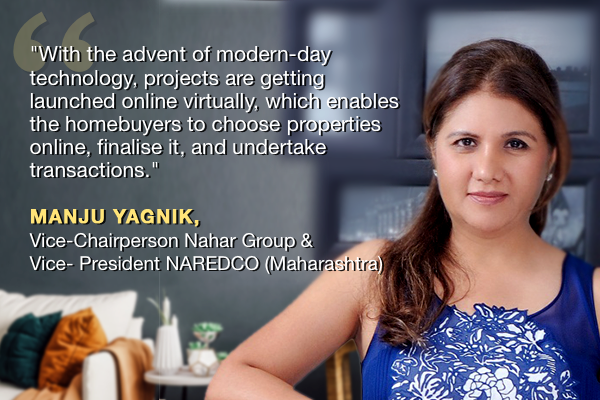“People are investing in real estate as they have realised the importance of owning a home during this phase,” said Manju Yagnik, Vice-Chairperson Nahar Group & Vice- President NAREDCO (Maharashtra).
In an exclusive interview with RoofandFloor, she spoke about how the company is realigning their business strategies to sustain in the coming times, future trends, and much more.
Here are the excerpts.
Firstly, how has the pandemic changed home buying in India?
Indian real estate industry is witnessing a technology-led home buying in India. Digital mode has emerged as the most preferred medium, which has made it possible to provide a virtual tour of the property to prospective homebuyers.

Such data-visualisation technology, chatbots, and video calls with real-life footage enable investors to identify and find out more about the property in question that meets their specific criteria, thus making the process faster as it is easier than a site visit.
Developers are choosing online webinars to reach out to channel partners, other stakeholders to showcase the project details.
Maharashtra government has also allowed registration of properties at the developer’s office, instead of visiting the registrar office which is normally very crowded. This also provides added convenience to homebuyers.
Have you started receiving inquiries?
For us, proper planning and switch to digital ensured the number of inquiries remained steady.
People are investing in real estate as they have realised the importance of owning a home during this phase. There is no doubt that home is the safest investment. Also, this is the most beneficial time for investors in real estate due to factors like home loan rates near two-decade low, reduced stamp duty in most states, and the fall in the Indian rupee which has made it easy for overseas investors to invest in India due to currency gain.
There is a considerable number of inquiries from the NRI community, especially from the Gulf countries, followed by the United States and other European countries. The currency fluctuation is also one of the reasons for high interest from the NRI community.
What are some trends that we can expect in the times to come?
The Indian real estate sector is at a transformation stage. As a responsible developer, we have acknowledged the changing preferences of the homebuyers, and are anticipating developmental and structural transformation in design.
Going forward, the concept of the integrated township, which allows residing in a given location, with all requirements fulfilled will pick up the pace. A residence in an integrated township allows to avoid unnecessary travel, and in some cases offers walk-to-workplace, other requirements like daily essentials, medical, schools, educational institutes, and a garden/park for recreational purpose. The concept of a spacious home, with a separate space for workstation and online classes for children, is possible in a township.
The smart home, as a concept, has gradually evolved. Consumers today want access to technologies and virtual assistants that can help them with daily chores, plan their day, and operate their appliances. Therefore, automated homes and Wi-Fi access streets will get more prominent. As per a study by Statista, nearly $3 billion Indian smart home market is expected to grow to become a $6 billion by 2022.
Should home seekers in MMR wait for property prices to correct or take the plunge?
Given the current equation, it favours homebuyers to invest in real estate.
Buyers stand to get a higher value for their money if they invest now.
Homebuyers should shortlist and purchase a property in a project which is well connected and built by a reputed developer.
The Central and the state government has announced a slew of measures, from a cut in stamp duty to extending the CLSS scheme by one year. RBI’s rate action has pushed lending rates to a two-decade low.
Your take on the future of residential real estate.
The lesson learned by all of us is that home is the most secured space, and it is a basic need for everyone. Hence, the demand for homes in an integrated township will increase. Smart homes will take precedence over regular homes. Homes with limited to zero-contact entry and exit points will be preferred.

